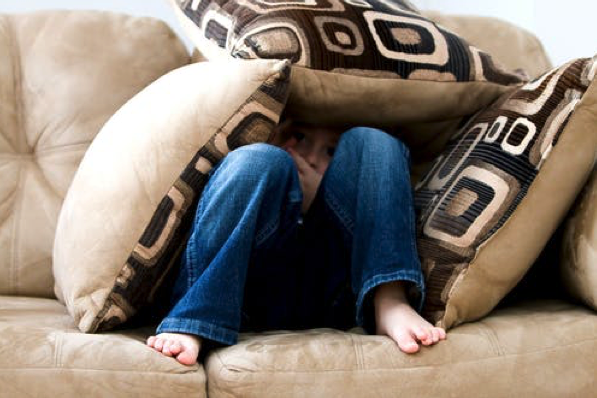
We all have fears, and this also applies to the youngest members of the family. Fear is considered a basic reaction for human functioning and development, as it helps us to protect ourselves from dangers and allows us to adapt to a great number of situations. In children this is even more true, being many of these fears transient. However, sometimes we may wonder if the fear they have is normal or not. Questions such as “Should I do something to try to solve this problem or will it disappear with time?” are very common among parents, especially first-time parents. To answers these questions, we must first know that there exist developmental fears, specific to each stage of development, and fears considered dysfunctional or “pathological”, such as phobias. But how can we know if our child’s fear is a normal fear or could be considered a phobia? In this article you will find indications that can help you to distinguish them.
Normal childhood fears
According to several authors, normal childhood fears are transitory, are linked to certain developmental stages and do not interfere in the child’s daily life. The role of these fears is important because they can help the children to avoid important dangers and can be useful for the acquisition of skills to face stressful life situations. They are, therefore, adaptive for the child. Empirical evidence shows that the most frequent normal fears shared by children at each stage are the following:
- First year (0 – 12 months): during the first part of this stage, babies are usually afraid of sudden loss of support and loud noises. Later, when they learn to discriminate between familiar and unfamiliar stimuli, they often develop fear of strangers. This fear may be reflected in withdrawal behaviours from strangers and constant searching for the parental figures.
- Early childhood (1 – 2.5 years): fear of separation from parents increases and fear of strange companions appears. Fears of storms, the sea and small animals are also frequent.
- Preschool (2.5 – 6 years): fear of the dark, of being alone and of animals are common at this stage, as well as the fear of imaginary beings, such as ghosts or monsters.
- Middle childhood (6 – 11 years): there is an increase of fears related to supernatural events, physical harm, and blood-injury-injection situations. There is also a predominance of fears related to health and death, and school (social aspects, classmates, academic performance, etc.).
- Early adolescence (11 – 13 years): social and school fears become more and more relevant. Economic and political fears emerge, as well as those related to self-concept (personal image, self-esteem, etc.).
- Adolescence (13 – 18 years): the fears of the early-adolescence stage continue its course but fears about self-concept and interpersonal relationships (with friends, people of the opposite sex, etc.) particularly increase.

How to manage normal childhood fears:
In general, these fears are not usually the aim of psychological attention, as they tend to subside over time due to factors such as neurological maturation, the development of the child’s cognitive abilities, and the natural exposure to the feared stimuli that helps to learn coping strategies. The main task of the caregivers is to provide knowledge and support to the child so that he can expose to these fears progressively and overcome them. Thus, he will learn which fears are dangerous and which are not, and how he should behave in fearful situations. All this will help the child to adequately overcome his fear and will strength his self-esteem and capacity of emotional regulation.
What can we do to help the child to overcome these fears?
- First, calm him down. Thanks to the established bond between parents and children, the simple presence of the former will calm the child down.
- Show affection and unconditional protection, in both verbal and non-verbal ways (hugging, holding hands, bending down to be at the same height, etc.).
- It is important to accompany the child, providing security and validating the emotions that he is feeling. In this sense, it is not appropriate to “tease” the child or get angry with him for being afraid. Instead, try to understand his emotions and allow him to express them. We should not say expressions such as “so big and you are still afraid?” or “I don’t care if you are afraid, go to bed”.
- Explain what the fear is, how it manifests itself and what it is used for. We must try to adapt our language to the current child’s cognitive level.
- Tell him, using an empathic attitude, that it is normal to be afraid and that we know how difficult it is, but that we are sure that he can overcome his fear.
- Revealing that we have also felt this fear or others, when we were small, can be very useful for the child to feel comprehended and realize that it is something that can be managed.
- Many times, it is enough to encourage the child not to avoid the feared situation, accompanying him, and wait for the fear to follow its developmental course and disappear.
- If we believe that the fear is spreading too much in time, we can encourage him to progressively face what he is afraid of, so that he experiences on his own that the feared consequence does not happen. At the beginning, we can accompany him to give him more security, always adopting an empathic attitude, calmly and without pressuring. Subsequently and progressively, we will have to encourage his autonomy so that he can face it on his own.
- Reinforce him positively every time he tries to expose himself to the fear, even if he does not succeed completely (for example, staying in the dark). Our reinforcement will the probability that he will want to try again.
Sometimes, we mistakenly think that we must protect children from anything that scares them. If we do this, the child will always avoid what he fears. Therefore, he will not realize that he can face those situations and that the feared consequences do not happen. We will also teach him that avoidance is the best way to face the things that we fear, so it is likely that he will maintain that fear and will develop others.
Childhood phobias
Unlike normal childhood fears, phobias are fears that can be maintained for many years (even until adulthood) and can interfere and generate problems in different areas of the child’s life. A fear can be categorized as a phobia when it generates significant discomfort and/or negative repercussions in one or more areas of the personal life. Let us think of a child who takes 2 hours to come from school instead of the 10 minutes-walk distance, because he avoids all the streets where finds a dog because he is terrified by them. In addition to the felt discomfort every time he runs into a dog, probably this behaviour generates other problems at the family level (he cannot eat at the same time as the rest of the family) or at the school level (he does not have enough time to do his homework or to attend extracurricular activities). This child has learned that the only way to alleviate this discomfort is avoiding what he fears. This pattern of avoidance does not allow the fear to be disproved and contributes to maintain it over time, turning it into a phobia.
In general, childhood phobias affect girls more than boys, both in number of cases and intensity of symptoms. Each type of phobia has prototypical onset ages. For example, animal phobia usually develops around age 7, while blood phobia starts around age 9 and social phobia around age 16. In some cases, children are not aware that their fears are irrational and sometimes do not show discomfort, so they do not always ask for help.
When should I seek professional help?
- The fear has been maintained for a long time and/or is increasing.
- The child constantly avoids some stimuli or situations related to what he is afraid of or reacts to them in a disproportionate way.
- It generates significant discomfort for the child or interferes in one or more areas of his life (school, family, interpersonal relationships, etc.).
- The child is performing certain rituals to reduce the anxiety caused by a stimulus or situation (for example, washing hands in a certain way to avoid spreading any disease, stepping only on certain parts of the street to avoid something bad happening to a family member, etc.).
If after reading this article, you still have doubts about whether your child’s fear is normal or may be “pathological”, or you do not know how to act, you can request a session with one of our professionals to guide you in this process.
Aina Fiol Veny (B-02615)







